- Running Course, Functions, and Disorders of the Du Mai
- Running Course, Functions, and Disorders of the Ren Mai
- Running Course, Functions, and Disorders of the Chong Mai
- Running Course, Functions and Disorders of the Dai Mai
- Running Course, Functions, and Disorders of Yangqiao Mai and Yinqiao Mai
- Running Course, Functions, and Disorders of Yangwei Mai and Yinwei Mai
Running Course, Functions, and Disorders of the Du Mai
1. Course
The du mai originates in the lesser abdomen, descends along the center of the pelvis (internal genitals), and emerges from the perineum between the genitals and the anus. It passes DU 1 (cháng qiáng) and travels at the posterior midline to DU 16 (fēng fŭ). From there it enters the brain and ascends to the vertex, descends along the midline of the forehead to the bridge of the nose, passes DU 25 (sù liáo) and DU 26 (shuĭ gōu), intersects with the hand yangming and foot yangming channels and terminates at DU 28 (yín jiāo) inside the upper lip at the labial frenulum (Pic. 1-53).
The divergent collateral of the du mai is ‘cháng qiáng’. It arises at DU 1 (cháng qiáng), ascends bilaterally along the muscles at the sides of the spine to the nape of neck, and disperses at the head. It reverses to descend along the sides of the scapula and branches into the foot taiyang bladder channel. It penetrates the muscles at the sides of the spine (Pic. 1-54).

Channel course summary
The du mai originates in the lesser abdomen, in the uterus of females and the essence chamber of males, with the ren mai and chong mai. It is said of these three that they have ‘one origin and three divisions’ .
It runs along the posterior midline. It is the sea of the yang channels and governs all of the yang channels of the body.
It ascends along the vertebral column to DU 16 (fēng fŭ), rises to the vertex, and descends along the midline of the forehead to the bridge of the nose.
It has a close association with the extraordinary fu organs, including the uterus, marrow, and brain.
2. Functions
The du mai is called the ‘sea of the yang channels’. It ascends to the head where yang gathers and connects with the brain. It runs up the posterior midline to the vertex and then to the anterior aspect of the face. The back belongs to yang, as do the head and face. All yang channels meet at the face. The du runs inside the vertebral column and connects with the three yang channels of the hand and foot at DU 14 (dà zhuī) and with the yangwei mai at DU 15 (yă mén) and DU 16 (fēng fŭ). Hence it governs all the yang channels of the body.
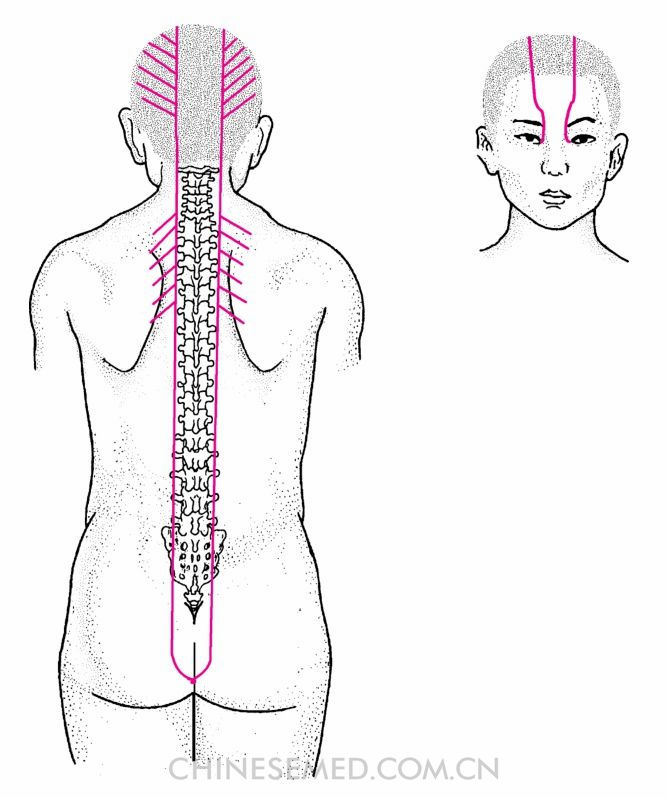
3. Disorders
Du mai symptoms are stiffiness of the spine and opisthotonos with cold that spreads throughout the body.
In the divergent collateral, the excess pattern presents as stiffiness of the spine and inability to bend forward or backward. The deficiency pattern presents as heaviness in the head and inability to turn or rotate. In treatment use the luo-connecting point, DU 1 (cháng qiáng).
Summary of du mai disorders
Disorders of the vertebral column: Acute lumbar sprain, ankylosing spondylitis.
Mental disorders: Du mai enters the brain; thus it can treat depression, mania, and epilepsy.
Disorders of the head: Headache, dizziness, amnesia, tinnitus, dizzy vision, insomnia, stiff neck.
Febrile diseases: High fever, deep-rooted boils.
Cold pattern: Aversion to cold, fear of cold, lack of warmth in the extremities.
Running Course, Functions, and Disorders of the Ren Mai
1. Course
The ren mai originates in the internal genitals. It emerges from the perineum between the genitals and the anus, ascends anterior to the pubic hair region, and rises along the anterior midline of the abdomen to arrive at RN 4 (guān yuán). It continues to ascend and travels along the throat to reach the jaw, then crosses the cheek, and enters the middle below the eyes (Pic. 1-55).
The divergent collateral of the ren mai is wĕi yì (尾翳). It descends from RN 15 (jiū wĕi) and disperses over the abdomen (Pic. 1-56).

Channel course summary
- The ren mai arises from the internal genitals with du mai and chong mai. It is said that these channels have ‘one origin and three divisions’.
- It belongs to yin. It travels along the anterior midline, connects with the three yin foot channels at RN 3 (zhōng jí) and RN 4 (guānyuán) at the lower abdomen.
2. Functions
The ren mai connects with all the yin channels of the body. ‘Ren’ has the meaning of ‘governing’ and ‘nourishing’. The channel originates in the uterus and is related to pregnancy and menstruation. As mentioned in The Yellow Emperor’s Inner Classic: BasicQuestions (Huáng Dì Nèi Jīng Sù Wèn, 黄帝内经素问): ‘At seven, a female’s kidney qi is exuberant; the teeth and hair grow. At fourteen, reproduction-stimulating essence (tiān guĭ, 天癸) arrives, ren mai is unobstructed, tai chong mai is exuberant, regular menstruation begins, and she can become pregnant.’ Because it intersects with the three yin channels of the foot, the yinwei mai, and the chong mai, the ren mai is known as the ‘sea of the yin channels’.
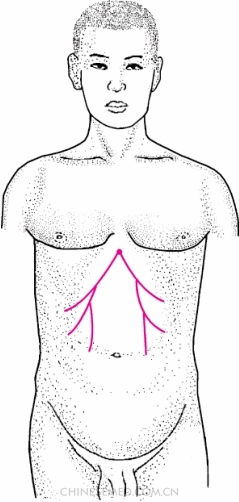
3. Disorders
When ren mai is disorderly, the flow of qi and blood in the channel becomes abnormal and stagnant. This presents as seven types of hernia in males and irregular menstruation, multicolored leucorrhea, and abdominal masses in females.
In divergent collateral disorders, the excess patten presents as pain, and the deficiency patten presents as itchy skin at the abdominal. To treat, use the luo connecting RN 15 (jiū wĕi).
Summary of ren mai disorders
External genitalia and reproductive disorders: Swelling and pain at the external genitalia, eczema, hernia, impotence, seminal emission, and infertility in males; irregular menstruation, dysmenorrhea, leucorrhea, infertility, and abdominal masses in females.
Mental disorders: Depression, mania, and epilepsy due to phlegm obstruction caused by qi constraint. The ren mai belongs to yin; dredging and unblocking the channel rectifies qi and dissolves phlegm.
Disorders based on different portions of the channel: The region below the umbilicus is responsible for disorders of the lower jiao, e.g., ischuria, enuresis, and pain in the lower abdomen. The region between the umbilicus and diaphragm is responsible for middle jiao spleen and stomach disorders, e.g., epigastric pain, vomiting, hiccup, distended abdomen, anorexia, and acid reflux. The region above the diaphragm is responsible for upper jiao heart and lung disorders, e.g., pain in the chest, coughing, asthma, pain in the heart, and palpitation.
Running Course, Functions, and Disorders of the Chong Mai
1. Course
The chong mai originates in the internal genitals, emerges from the perineum between the genitals and the anus, ascends to qi pathway (ST 30, qì chōng), and connects with the foot shaoyin kidney channel. It then ascends and distributes in the chest.
(1) One branch ascends from the chest to the throat and curves around the lips. Its qi and blood diffuses into all the yang channels and infuses the essence.
(2) Another descends from the qi pathway, converges with the kidney channel, travels along the medial aspect of the inguinal region and enters the popliteal fossa. It then travels from the medial aspect of the tibia to the posterior aspect of the medial malleolus and permeates the three yin channels.
(3) A third separates at the posterior aspect of the medial malleolus, travels at the dorsum of the foot, and enters the big toe.
(4) A fourth travels posterior to the uterus and runs inside the spine (Pic. 1-57).
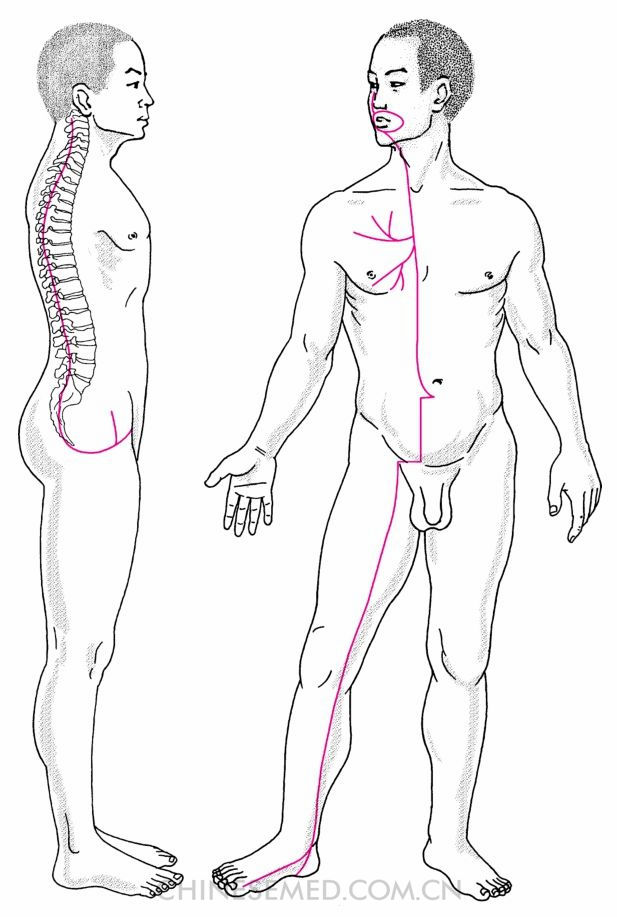
Channel course summary
- The chong mai arises in the uterus with ren mai and du mai; these three channels have ‘one origin and three divisions’.
- It associates with the ren mai and all the yin and yang channels, so it is called the ‘sea of the twelve regular channels’.
2. Functions
The chong mai is known as the ‘sea of the twelve regular channels’ and the ‘sea of blood’. It originates in the uterus with the ren mai and diffuses into all the yang channels, infuses the essence, connects with the three yin channels, and is responsible for nourishing the channels in the body with qi and blood. With the ren mai, it is responsible for pregnancy and fetal nourishment, enriching the essential qi in the kidney to nourish the hair and beard, and developing essence into tiān guĭ (天癸). It is known as the sea of the twelve regular channels; each channel belongs to a zang-fu organ, the chong mai is also known as the reservoir of the zang-fu organs. Moreover, as the sea of blood, it nourishes the zang-fu organs and the channels.
3. Disorders
When the chong mai is diseased, the symptoms can manifest as ascending counterflow of qi, abdominal spasms, bulging of the abdominal skin, back pain due to abdominal pain caused by ulceration and intumescence of external genitalia, enuresis, incontinence, fullness in the region of the floating ribs, irritation, and infertility.
Summary of chong mai disorders
Gynecological disorders: Menstruation, pregnancy, parturition.
Ascending counterflow of qi that presents as heart pain, irritation, chest tightness, distention in the hypochondrium, abdominal pain and urgency.
Running Course, Functions and Disorders of the Dai Mai
1. Course
Dai mai starts at the region of the floating ribs below the hypochondrium and runs transversely around the waist like a belt (Pic. 1-58).
Channel course summary
- Dai mai belongs to yang.
- It runs transversely around the waist like a belt at the level of the umbilicus at the front and the second lumbar vertebra at the back.
- It connects with GB 26 (dài mài), GB 27 (wŭ shū), and GB 28 (wéi dào) of the foot shaoyang gallbladder channel.
2. Functions
Dai mai runs transversely around the waist and has the functions of binding and restricting other channels. It has regulating effects, especially regarding kidney qi. Thus it regulates menstruation and leukorrhea in females and consolidates the kidney and nourishes essence in males.
3. Disorders
‘When the dai mai is diseased, it presents as abdominal bulging and fullness and coldness and weakness at the lumbar region as though sitting in water’, according to The Yellow Emperor’sClassic of Eighty-one difficult Issues-The Twenty-ninth difficulty (Huáng Dì Bā Shí Yī Nàn Jīng-Èr Shí Jiǔ Nàn, 黄帝八十一难经·二十九难).
Summary of dai mai disorders
- Channel diseases: Lumbar pain, abdominal distention.
- Gynecological disorders: Menstrual disorders; multicolored leucorrhea, often with tenderness at GB 26 (dài mài). Moxibustion treatment is effective.
Running Course, Functions, and Disorders of Yangqiao Mai and Yinqiao Mai
1. Course
The yangqiao mai starts at the lateral side of the heel and emerges at BL 62 (shēn mài) of the foot taiyang bladder channel. It runs posterior to the lateral malleolus and ascends along the thigh to the hypochondrium and shoulder. It then travels at the face, intersects the yinqiao mai and foot taiyang bladder channel at the medial canthus, and joins BL 1 (jīng míng). It enters the brain, descends behind the ear, and enters GB 20 (fēng chí) (Pic. 1-59).

The yinqiao mai starts at the heel and emerges at KI 6 (zhào hăi) of foot shaoyin kidney channel. It ascends along the medial malleolus to the inguinal region and into the genitals. It then moves inside the chest to the throat, intersects with the chong mai, and enters the zygomatic region. It converges with the foot taiyang bladder channel and yangqiao mai at the medial canthus and continues to ascend with them (Pic. 1-60).
Channel course summary
- The yangqiao mai is a branch of the foot taiyang bladder channel. It travels at the lateral aspect of the lower limbs.
- The yinqiao mai is a branch of the foot shaoyin kidney channel. It travels at the medial aspect of the lower limbs to the throat to intersect with the chong mai.
- Yinqiao and yangqiao mai converge at the medial canthus, intersect at BL 1 (jīng míng), and enter the brain.
2. Functions
Qiáo means agility. The yangqiao mai and yinqiao mai are responsible for the movements of the body. Movement belongs to yang; stillness belongs to yin. Both channels arise at the heel and connect with the foot shaoyin kidney and foot taiyang bladder channels. The yangqiao mai and yinqiao mai ascend to the eye and enter the brain. Wei qi travels around the whole body, harmonizes yin-yang and is inseparable from the functions of these two channels. During the day, yang qi is abundant and wei qi travels at yang: the yangqiao mai is dominant and accountable for normal activities, the eyes remain open, and the individual stays awake. At night, yin qi is abundant and wei qi travels at yin: the yinqiao mai is dominant and accountable for rest, the eyes close, and sleep arrives. Thus yangqiao mai and yinqiaomai have a close relationship to a person’s normal activities.
3. Disorders
When there is an overabundance of yang, the yangqiao mai is saturated. The eyes remain wide open, and there is insomnia. When there is an overabundance of yin, the yinqiao mai is saturated, both eyes close, and sleep arrives.

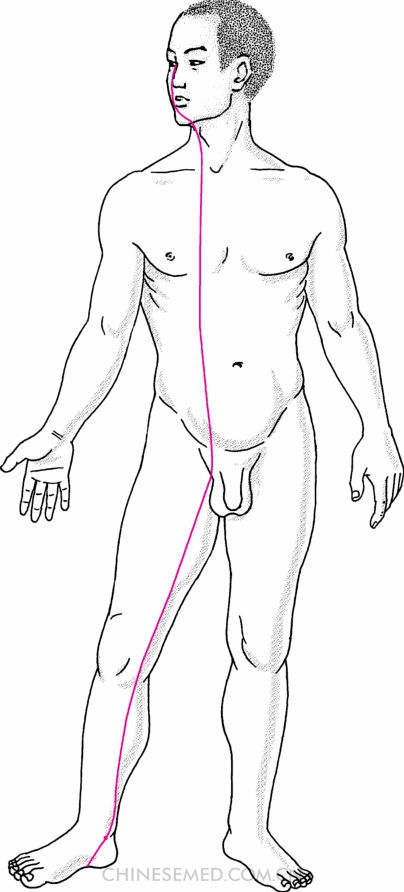
Disorders of the yangqiao mai produce flaccidity of the muscles above the medial malleolus and spasms of the muscles above the lateral malleolus. Disorders of the yinqiao mai produce flaccidity of the muscles above the lateral malleolus and spasms of the muscles above the medial malleolus.
Summary of yangqiao mai and yinqiao mai disorders
- Abnormal sleep: Insomnia or somnolence.
- Difficulties in mobility: Stroke or infantile cerebral palsy resulting in talipes varus or or talipes valgus.
- Depression and epilepsy: That occurring in the yangqiao mai belongs to the yang syndrome; it occurs during the day and is related to the foot taiyang bladder channel. That occurring in the yinqiao mai belongs to the yin syndrome; it occurs at night and is related to the foot shaoyin kidney channel.
Running Course, Functions, and Disorders of Yangwei Mai and Yinwei Mai
1. Course
The yangwei mai starts at BL 63 (jīn mén) of the foot taiyang bladder channel. It ascends from the lateral aspect of the lower leg to the lateral aspect of the shoulder and head. It converges with the du mai at DU 16 (fēng fŭ) and DU 15 (yă mén) at the nape of the neck (Pic. 1-61).
The yinwei mai starts at KI 9 (zhù bīn) of the foot shaoyin kidney channel. It ascends along the medial aspect of the lower limb to the abdomen and converges with the ren mai at RN 22 (tiān tū) and RN 23 (lián quán) at the neck (Pic. 1-62).
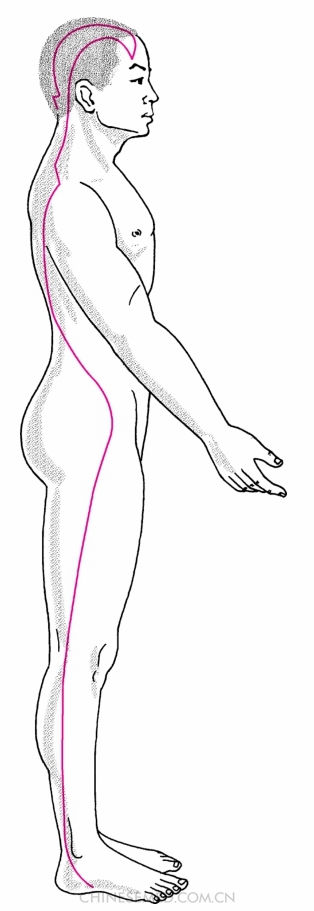
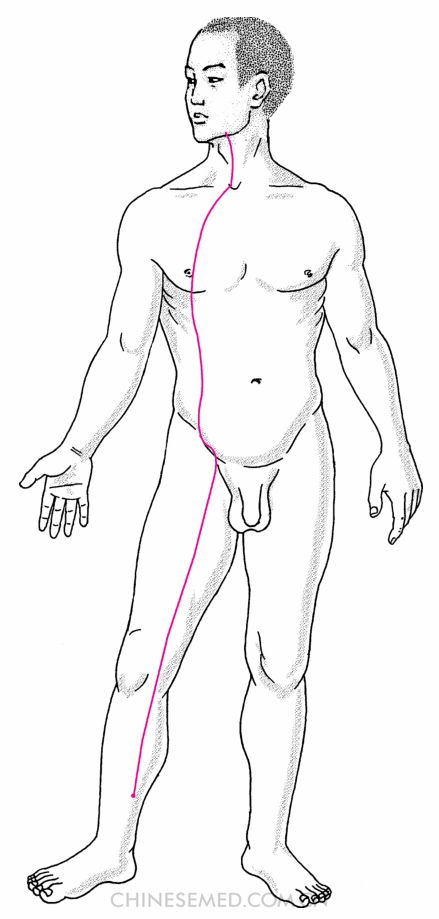
Channel course summary
- The yangwei mai travels at the lateral aspect of the lower limbs. It intersects the foot taiyang bladder, foot shaoyang gallbladder, hand shaoyang san jiao and hand taiyang small intestine channels, and du mai.
- The yinwei mai travels at the medial aspect of the lower limb. It intersects the foot shaoyin kidney, foot taiyin spleen and foot jueyin liver channels, and ren mai.
2. Functions
The yangwei mai and yinwei mai connect the entire body. They conserve qi and blood that circulate outside the twelve channels. The yangwei mai joins the du mai and connects to all the yang channels. The yinwei mai joins the ren mai and connects to all the yin channels.
3. Disorders
Yangwei mai disorders often present as aversion to cold with fever. If there are disorders in the yinwei mai, there is pain in the heart.
Summary of yangwei mai and yinwei mai disorders
Exterior patterns: Aversion to cold with fever.
Interior patterns: Heart pain.

